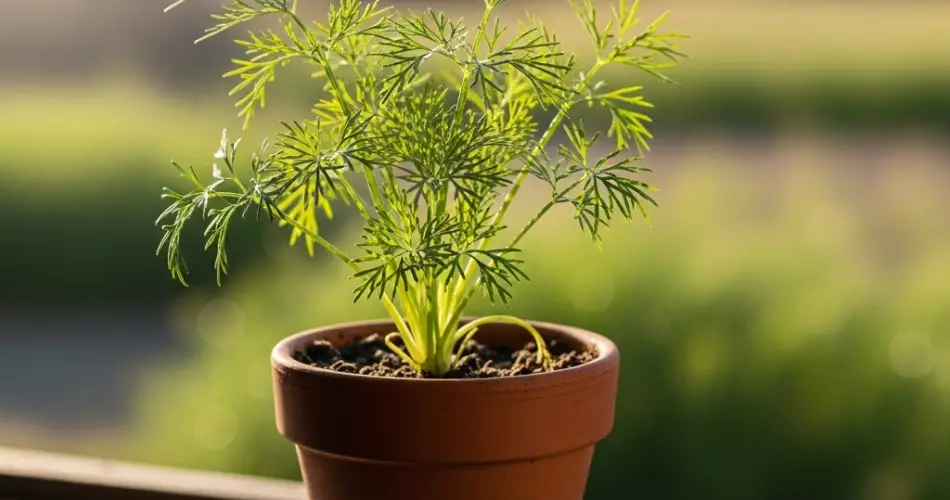Dill is a fragrant, feathery herb that has long been prized in kitchens around the world. From flavoring pickles and soups to garnishing fresh salads and fish dishes, this herb offers both culinary versatility and ornamental charm. The best part? You don’t need a large outdoor garden to enjoy dill. With the right approach, you can successfully grow it in a pot, making it accessible to urban gardeners, apartment dwellers, and anyone who appreciates fresh herbs within arm’s reach.
This guide explores everything you need to know about growing dill in containers, from choosing the right pot to harvesting fresh leaves and seeds.
Why Grow Dill in Pots?
Growing dill in pots offers several advantages. First, it allows you to cultivate this herb in small spaces, whether on a balcony, patio, windowsill, or even indoors with sufficient light. Container gardening also makes it easier to control soil quality, drainage, and water levels. Plus, pots let you move the plant to chase the sun or protect it from harsh weather.
Dill is known for its deep taproot, which can sometimes make it challenging in shallow soils. By selecting a container with the right depth, you can provide the root space it needs while keeping the plant manageable in size.
Choosing the Right Pot
Because dill develops a long taproot, it requires a container that is at least 12 inches deep. A pot with good drainage holes is essential to prevent soggy soil, which can lead to root rot. Clay or terracotta pots are excellent choices because they allow excess moisture to evaporate, but plastic pots are lighter and easier to move around.
If you’re planting multiple dill seeds, choose a wide pot to accommodate several plants while giving each enough space to grow. Overcrowding can lead to weak stems and reduced airflow, making the plant more prone to pests and diseases.
Soil Requirements
Dill thrives in light, well-draining soil. A high-quality potting mix with added compost works best. Avoid heavy soils that retain too much water, as dill dislikes “wet feet.” If you prefer a homemade mix, combine two parts potting soil, one part sand or perlite, and one part compost. This ensures good drainage while still providing the nutrients needed for healthy growth.
Planting Dill in Pots
Dill is best grown from seed, as it doesn’t transplant well due to its taproot. Direct sow the seeds into the prepared pot, scattering them lightly and covering with about ¼ inch of soil. Water gently to settle the seeds in place.
Seeds usually germinate within 10 to 14 days. Once seedlings are a few inches tall, thin them to about 8 to 10 inches apart, depending on the pot size. This gives each plant enough room to spread its delicate, fern-like foliage.
Light and Temperature Needs
Dill loves the sun and needs at least six hours of direct light daily. If growing indoors, place the pot near a sunny window or supplement with a grow light. Outdoors, position the pot in a sunny spot, but if you live in a very hot climate, some afternoon shade can prevent the plant from drying out too quickly.
The plant prefers cooler weather and grows best in spring and early summer. In regions with very hot summers, consider sowing dill again in late summer for a fall harvest.
Watering and Feeding
Container-grown dill should be watered regularly, but avoid overwatering. Let the top inch of soil dry out before giving the plant a deep drink. Consistency is key—too much dryness can stress the plant, while soggy soil leads to weak growth.
Dill doesn’t need heavy feeding. A diluted, balanced liquid fertilizer once a month during the growing season is usually enough. Too much fertilizer, especially nitrogen, can cause tall, leggy plants with fewer flavorful leaves.
Supporting Tall Stalks
As dill matures, it can grow tall and slender, sometimes reaching two to three feet in height. In containers, this makes it more prone to tipping over. To keep it upright, use bamboo stakes, a small tomato cage, or a decorative trellis. Gently tie the stalks with soft twine to prevent damage.
Harvesting Dill
You can begin harvesting dill leaves once the plant reaches about 8 inches tall. Snip sprigs as needed, starting from the outside of the plant. Regular harvesting encourages bushier growth and prevents the plant from becoming too leggy.
Dill will eventually produce flower heads, which can be left to develop seeds. These seeds are excellent for pickling or saving for the next planting season. However, once the plant flowers, leaf production slows, so if your main goal is fresh leaves, pinch off flower buds to prolong the harvest period.
Common Challenges in Pot-Grown Dill
-
Bolting in hot weather: Dill tends to flower quickly in high heat. To manage this, sow seeds successively every few weeks for a continuous supply.
-
Aphids and pests: Check the foliage regularly for pests. A gentle spray of water or neem oil can help keep them in check.
-
Weak stems: This often results from overcrowding or insufficient light. Thin seedlings and ensure proper sunlight exposure.
Conclusion
Growing dill in pots is both practical and rewarding. With the right pot depth, well-draining soil, and consistent care, you can enjoy fresh, fragrant leaves and seeds just steps from your kitchen. Container gardening makes dill accessible to anyone, no matter how limited their outdoor space.
Whether you want a garnish for salads, seasoning for fish, or flavorful seeds for pickling, a pot of dill brings fresh flavor and beauty right to your home. By giving this airy herb the care it needs, you’ll enjoy a continuous supply of greenery and a touch of garden freshness in your cooking.



